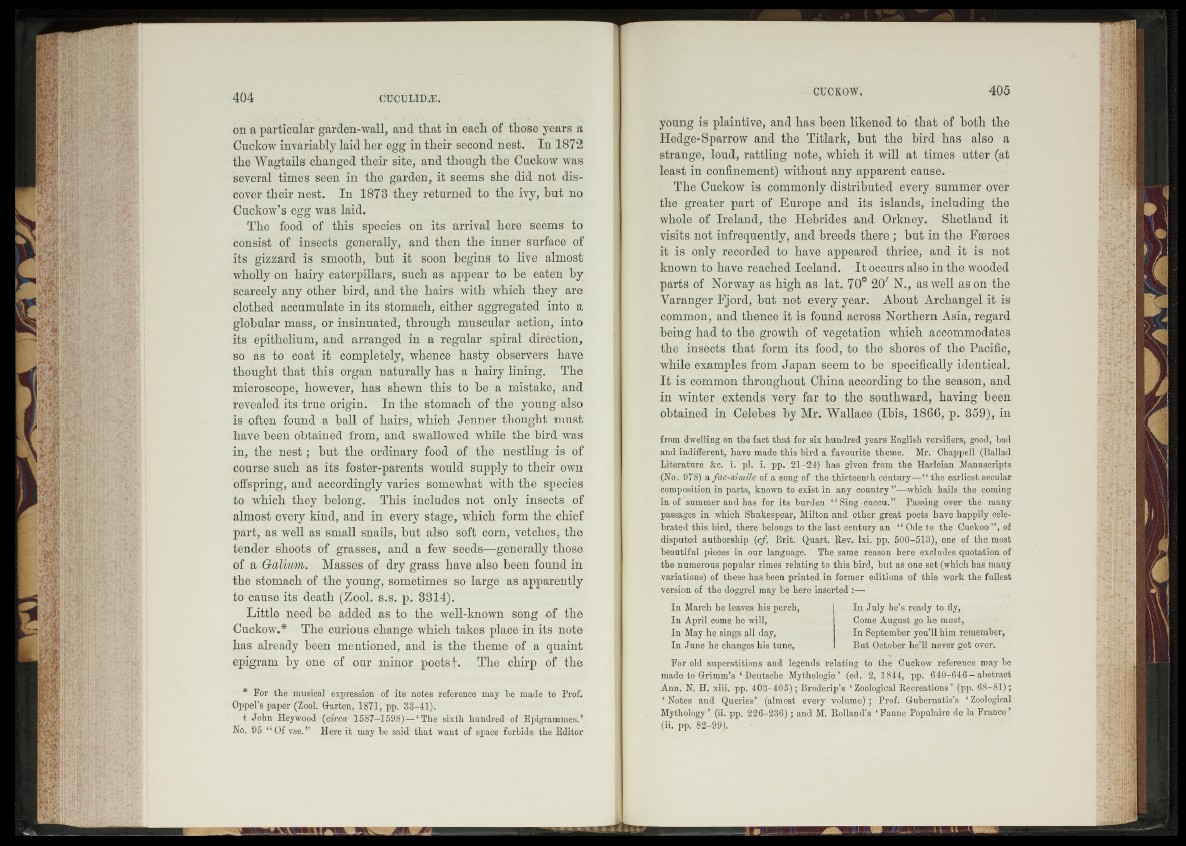
on a particular garden-wall, and tliat in each of those years a
Cuckow invariably laid her egg in their second nest. In 1872
the Wagtails changed their site, and though the Cuckow was
several times seen in the garden, it seems she did not discover
their nest. In 1873 they returned to the ivy, but no
Cuckow’s egg was laid.
The food of this species on its arrival here seems to
consist of insects generally, and then the inner surface of
its gizzard is smooth, but it soon begins to live almost
wholly on hairy caterpillars, such as appear to be eaten by
scarcely any other bird, and the hairs with which they are
clothed accumulate in its stomach, either aggregated into a
globular mass, or insinuated, through muscular action, into
its epithelium, and arranged in a regular spiral direction,
so as to coat it completely, whence hasty observers have
thought that this organ naturally has a hairy lining. The
microscope, however, has shewn this to be a mistake, and
revealed its true origin. In the stomach of the young also
is often found a ball of hairs, which Jenner thought must
have been obtained from, and swallowed while the bird was
in, the n e st; but the ordinary food of the nestling is of
course such as its foster-parents would supply to their own
offspring, and accordingly varies somewhat with the species
to which they belong. This includes not only insects of
almost every kind, and in every stage, which form the chief
part, as well as small snails, but also soft corn, vetches, the
tender shoots of grasses, and a few seeds—generally those
of a Galium. Masses of dry grass have also been found in
the stomach of the young, sometimes so large as apparently
to cause its death (Zool. s.s. p. 3814).
Little need be added as to the well-known song of the
Cuckow.* The curious change which takes place in its note
has already been mentioned, and is the theme of a quaint
epigram by one of our minor poets f. The chirp of the
* For the musical expression of its notes reference may be made to Prof.
Oppel’s paper (Zool. Garten, 1871, pp. 38-41).
t John Heywood (circa 1587-1598)—‘ The sixth hundred of Epigrammes.’
No. 95 “ Of vse.” Here it may be said that want of space forbids the Editor
CUCKOW. 405
young is plaintive, and has been likened to that of both the
Hedge-Sparrow and the Titlark, but the bird has also a
strange, loud, rattling note, which it will at times utter (at
least in confinement) without any apparent cause.
The Cuckow is commonly distributed every summer over
the greater part of Europe and its islands, including the
whole of Ireland, the Hebrides and Orkney. Shetland it
visits not infrequently, and breeds there ; but in the Faeroes
it is only recorded to have appeared thrice, and it is not
known to have reached Iceland. It occurs also in the wooded
parts of Norway as high as lat. 70° 20/ N., as well as on the
Varanger Fjord, but not every year. About Archangel it is
common, and thence it is found across Northern Asia, regard
being had to the growth of vegetation which accommodates
the insects that form its food, to the shores of the Pacific,
while examples from Japan seem to be specifically identical.
It is common throughout China according to the season, and
in winter extends very far to the southward, having been
obtained in Celebes by Mr. Wallace (Ibis, 1866, p. 359), in
from dwelling on the fact that for six hundred years English versifiers, good, bad
and indifferent, have made this bird a favourite theme. Mr. Chappell (Ballad
Literature &c. i. pi. i. pp. 21-24) has given from the Harleian Manuscripts
(No. 978) a facsim ile of a song of the thirteenth century—-“ the earliest secular
composition in parts, known to exist in any country ”—which hails the coming
in of summer and has for its burden “ Sing cuecu.” Passing over the many
passages in which Shakespear, Milton and other great poets have happily celebrated
this bird, there belongs to the last century an “ Ode to the Cuckoo ” , of
disputed authorship (cf. Brit. Quart. Rev. Ixi. pp. 500-513), one of the most
beautiful pieces in our language. The same reason here excludes quotation of
the numerous popular rimes relating to this bird, but as one set (which has many
variations) of these has been printed in former editions of this work the fullest
version of the doggrel may be here inserted :—
In March he leaves his perch,
In July he’s ready to fly,
In April come he will,
Come August go he must,
In May he sings all day,
In September you’ll him remember,
In June he changes his tune,
But October he’ll never get over.
For old superstitions and legends relating to the Cuckow reference may be
made to Grimm’s ‘ Deutsche Mythologie’ (ed. 2, 1844, pp. 640-646 —abstract
Ann. N. H. xiii. pp. 403-405); Broderip’s ‘ Zoological Recreations’ (pp. 68-81);
‘ Notes and Queries’ (almost every volume) ; Prof. Gubernatis’s ‘ Zoological
Mythology’ (ii. pp. 226-236); and M. Rolland's ‘Faune Populaire de la France’
(ii. pp. 82-99).